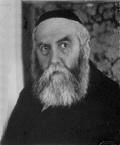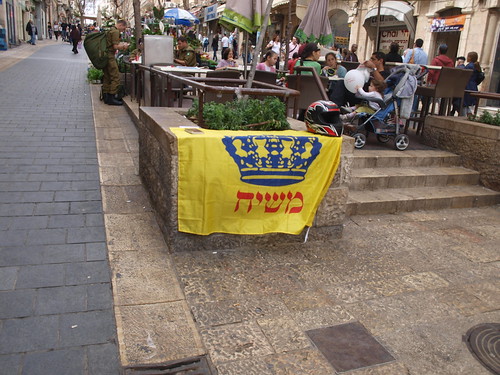The Rebbe: The Life and Afterlife of Mendel Menachem Schneerson by Samuel Heilman and Menachem Friedman is the first non-hagiographic biography of the final leader of the Jewish Chabad Lubavitch sect. Over the course of forty years of leadership, he turned the tiny Russian sect into a global order whose trademark services, such as Chabad Houses in far-flung areas without a significant Jewish presence and nearly 1500 websites disseminating information on its brand of Judaism, are recognised and utilised by Jews of every creed.

Lubavitchers are the Jewish guys in fedoras you see wandering around looking like they just walked out the 1950s, if not earlier. Chabad Lubavitch was born in the late 18th century by Shneur Zalman of Liadi, and takes its name from Lyubavichi, the Russian town where the group was based until the early 20th century. The Rebbe became leader of Lubavitch in 1951 after a slow-burning popularity competition with his brother-in-law and died after a stroke in 1992. By the time of his death, he had founded thousands of synagogues, schools, and Jewish institutions of learning. However, such phenomenal expansion cannot entirely hide the fact that the introspective atmosphere of Chabad Lubavitch and the Rebbe’s increasing fixation on the end of the world as we know it, resulted in a movement that acclaimed him as the Messiah in life, and after his inconvenient death, is torn between preserving his memory or awaiting his return.
The Rebbe has generated a fabulous amount of controversy, and for good reason – being told that the spiritual leader you idolise and look to as a perfect example of manhood was actually largely uninterested in spiritual leadership and never even gained ordination as a rabbi can never go down well. But it nonetheless cannot be helped: over the course of a good two chapters, I don’t think it can really be disputed that the authors firmly establish that Mendel Menachem Schneerson’s primary motivation in life prior to his move to America in 1941 was not to become a Rebbe, but to become a mechanical engineer. Although correspondence with his father-in-law Rebbe Yosef Yitzchok Schneersohn demonstrates that Mendel Menachem remained thoroughly committed to Hasidic Jewish practice as an individual, he nonetheless chose to spend much of his life outside Jewish communities, studying in institutions in Latvia, Berlin and Paris, forced to move from one place to another as Soviet and Nazi anti-Semitism closed in, leaving a trail of less-than-brilliant transcripts behind him as he was unable to obtain dispensation from attending classes or exams on Shabbat or Jewish festivals. The authors don’t make this point, but certainly I found it worthy of note that by the time the Rebbe finally graduated from a French technical college in 1937, he had been struggling his way through academia for over 15 years.
Spending 15 years on earning a degree implies a kind of tenacity that most of us can only admire. So much more, then, did I feel for the mechanical engineer that never was when the book swiftly goes on to describe the increasing influence of the Nazis and Mendel Menachem’s successful graduation being immediately buried under the urgency of having to flee Europe, and the discovery that in America, being a 39 year old immigrant unable to speak English and holding a hard-earned French degree that no American employer could understand meant that he had little chance of ever actually having the career he had spent so long working towards. Little wonder then, that he finally turned back to the community that welcomed him with open arms as the son-in-law of Rebbe Yosef Yitzchok with an extensive knowledge of Hasidic philosophy and customs. The authors make a link, however, between the Rebbe’s extensive engineering training and the methodical and rigorous manner in which he expanded his previously small and parochial sect. I suspect that that is probably justified.

One thing that is substantially missing from this book is a sense of what Mendel Menachem’s personality was like. He is obviously lauded as a fatherly, insightful, brilliant scholar by his followers, but you get little sense in The Rebbe about what he actually enjoyed doing. Did he have spare time? How did he relax? Who did he talk to about his ministry who wasn’t his long deceased father-in-law? The Rebbe’s influences, as opposed to whom he influenced, is relatively unexplored.
There’s also little hints which are not explored of the less pious side of the Rebbe – for example, the fact that he sued his own nephew over the ownership of the Chabad library, and then, when he won, declared a public holiday for all of his hasidim, which he named “Didan Notzach” or “Our Side Won”, strikes me as being just a little bit vindictive. When, in 1927, the authors are describing the arrest of the Previous Rebbe, Yosef Yitzchok, in Soviet Russia, they note very briefly that Mendel Menachem had been out with the Rebbe’s daughter alone until midnight, mainly to state that the hasidic accounts of the evening gloss over this detail. However, they do so as well. Add also to this the fact that Mendel Menachem and his fiancée dated for nearly six years before they married, and that he trimmed his beard even though the Previous Rebbe specifically demanded his hasidim wear their beards long. The authors draw from these facts an observation that the Rebbe wasn’t heavily involved with the hasidic movement for much of his life – I cannot help but draw from it a certain amount of disrespect and defiance for the people who supported him. The Rebbe’s education was entirely paid for by Rebbe Yosef Yitzchok from Chabad funds, and in return, he refused to wear traditional Hasidic dress to his own wedding reception, customarily an opportunity for the Rebbe to demonstrate his power and influence. Even the authors interpret a minor incident involving the serving of water at the reception to indicate that Rebbe Yosef Yitzchok was embarrassed by his new son-in-law. Perhaps it is difficult to infer attitudes from letters and diaries of the time, but nonetheless, there are some very interesting stories about the Rebbe which seem more significant than the authors are willing to grant space to.

The book is evidently intended to dig up back history of the Rebbe that has long been glossed over by his followers, and contains very little information about his religious thought or writings. While I understand that for the sake of space, there is little point in dwelling on the Rebbe’s extensive output (even though much of his work remains unpublished, the published writings and transcripts still run to several tens of thousands of pages), as someone who has very little understanding of hasidic thought, it would’ve been nice if the authors had spent a little longer on explaining what exactly he got up to in his first two decades as Rebbe. This omission means that many questions arose for me in the reading that went unanswered, such as: Why did the Rebbe tell his emissaries to reach out to all Jews, but seemingly delivered all his discourses in Yiddish? How did he acquire enough knowledge of hasidic texts to be able to deliver hour long discourses several times a week for forty years when he never attended a yeshiva? When did he ever find time to write or prepare anything when he was being almost constantly sought out by his hasidim for advice?
It might seem that an inordinate amount of time is spent on his upbringing as opposed to his tenure, but this is actually in proportion to his life. Nonetheless the impact of the Rebbe as Rebbe as opposed to as Mendel Menachem Schneerson was significantly greater, but over 150 pages, I gained little insight into what he actually achieved outside of launching the Mitzvah and Moshiach campaigns. Rabbi Shmuley Boteach gives a brief outline in his Amazon review: “I watched the rebbe lead Lubavitch since I was 9 years old. It was a herculean undertaking with responsibilities that would boggle the mind. It meant keeping up with and responding to sacks of personal letters each week, overseeing a global empire of thousands of Chabad synagogues, schools, teaching colleges, orphanages, and drug rehabilitation centres, most of which the rebbe, through his emissaries, built. Each week he met in the middle of the night with individuals privately to discuss their most personal issues, giving a weekly (and sometimes twice weekly) public oration that lasted, on average, for four hours through which the rebbe gave masterful scholarly discourses without a single written note. Well into his 80s he stood on his feet every Sunday for hours giving thousands of visitors a dollar for tzedakah in order to meet them face to face and inspire them to do good acts.” The sheer size and complexity of the organisation is alluded to but rarely considered. This is a book on the Rebbe, not Chabad, so fair enough, but his involvement with it as it built up around him seems to go unmentioned in favour of his political activity, although surely the Chabad Houses around the world will last much longer.
I wanted this book originally because the Rebbe remains endlessly fascinating to me. Willingly taking on a role that leaves you the absolute authority on spiritual, personal and business matters to hundreds of thousands of men and women who will devotedly go wherever you send them and do whatever you tell them to, must have a very corrupting influence on any man’s psyche. The increasing belief of the Rebbe in his later years that he was the Messiah poses a problem for the authors, who have clearly never been in such a position. They faithfully narrate the story of how the Rebbe, increasingly isolated and without advisors to give him perspective after the death of his wife, encouraged his followers to believe that he was the Messiah waiting to be unveiled and how he struggled to reconcile that position with his encroaching illness and mortality and the fact that the world was stubbornly not ending. But they do not, and cannot, tell me what on earth was going through the Rebbe’s mind – and that I am unlikely to find out.

But I have learned much else besides, and enjoyed it, though other reviewers have not. I would recommend this book to anyone who would like to know more about such an influential figure in Orthodox Judaism today – more biographies are in the process of being written, but this is the first substantial one. Go read it! For those who are very interested in minutiae, you can also read a month long academic deathmatch regarding the book’s content between the authors and Chabad Rabbi Chaim Rapoport here.
Check out the book and its reviews on Amazon here:
And thank you very much to my flatmate Miles for buying me the book for my birthday!